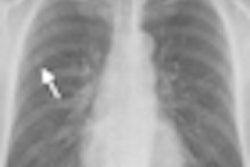
NEW YORK (Reuters Health), May 20 - Measurement of serum cystatin C helps diagnose early acute contrast-induced kidney injury, and it also helps predict its course, Italian researchers report.
For the vast majority of patients with chronic kidney disease, these findings may allow earlier discharge after their procedures, "with associated practical and economic advantages," lead author Dr. Carlo Briguori, of Clinica Mediterranea, Naples, told Reuters Health by e-mail.
Currently the diagnosis depends on changes in serum creatine (Cr) -- specifically, a rise of at least 0.3 mg/dL (or at least 25%) from baseline at 48 hours. But the 48-hour wait sometimes causes contrast-induced kidney injury to be overlooked, and in other cases it results in a longer-than-necessary hospital stay because "the vast majority of patients" will not have any problems from the contrast media, Dr. Briguori said.
In 410 patients with chronic kidney disease who underwent coronary and/or peripheral angiography and/or angioplasty, Dr. Briguori and his colleagues measured cystatin C at baseline and 24 hours, and Cr at baseline, 24, and 48 hours.
In the May 18 issue of Circulation, the researchers report that 34 patients (8.2%) developed acute kidney injury within 48 hours after contrast exposure. Overall, 87 patients (21.2%) had a cystatin C increase of at least 10% at 24 hours. This cutoff turned out to be the best for early identification of patients at risk for a Cr rise of at least 0.3 mg/dL, with a sensitivity of 100% and a specificity of 85.9%. (The negative and positive predictive values were 100% and 39.1%, respectively.)
The researchers also had one-year outcome data for 377 patients (92%). Thirty-four (9.0%) either died or had major deterioration leading to chronic dialysis. These endpoints occurred in 16 of 297 patients (5.4%) with cystatin C < 10% and Cr increase < 0.3 mg/dL, 9 of 49 (18.4%) with elevated cystatin C but Cr increase < 0.3 mg/dL, and 9 of 31 (29%) with elevations in both markers.
On logistic regression analysis, the independent predictors of all-cause mortality or chronic dialysis at one year were baseline estimated glomerular filtration rate (OR = 0.91) and a cystatin C level of 10% or more, either alone (odds ratio = 2.52, p = 0.02) or in association with a Cr increase of more than 0.3 mg/dL (OR = 4.45, p = 0.002).
Noting that cystatin C allowed them to identify patients at higher risk for adverse events in the coming year, the authors suggest that cystatin C "may provide prognostic information beyond its role as an index of kidney function and also may be a better overall measure of the spectrum of pathophysiological abnormalities that accompany kidney disease."
Indeed, they add, in the Dallas Heart Study cystatin C was linked with cardiac structural abnormalities, and other reports have linked it with inducible myocardial ischemia.
By Michelle Rizzo
Circulation 2010;121:2117-2122.
Last Updated: 2010-05-19 16:55:27 -0400 (Reuters Health)
Related Reading
Study confirms link between angio contrast and long-term kidney damage, June 25, 2009
Copyright © 2010 Reuters Limited. All rights reserved. Republication or redistribution of Reuters content, including by framing or similar means, is expressly prohibited without the prior written consent of Reuters. Reuters shall not be liable for any errors or delays in the content, or for any actions taken in reliance thereon. Reuters and the Reuters sphere logo are registered trademarks and trademarks of the Reuters group of companies around the world.


















